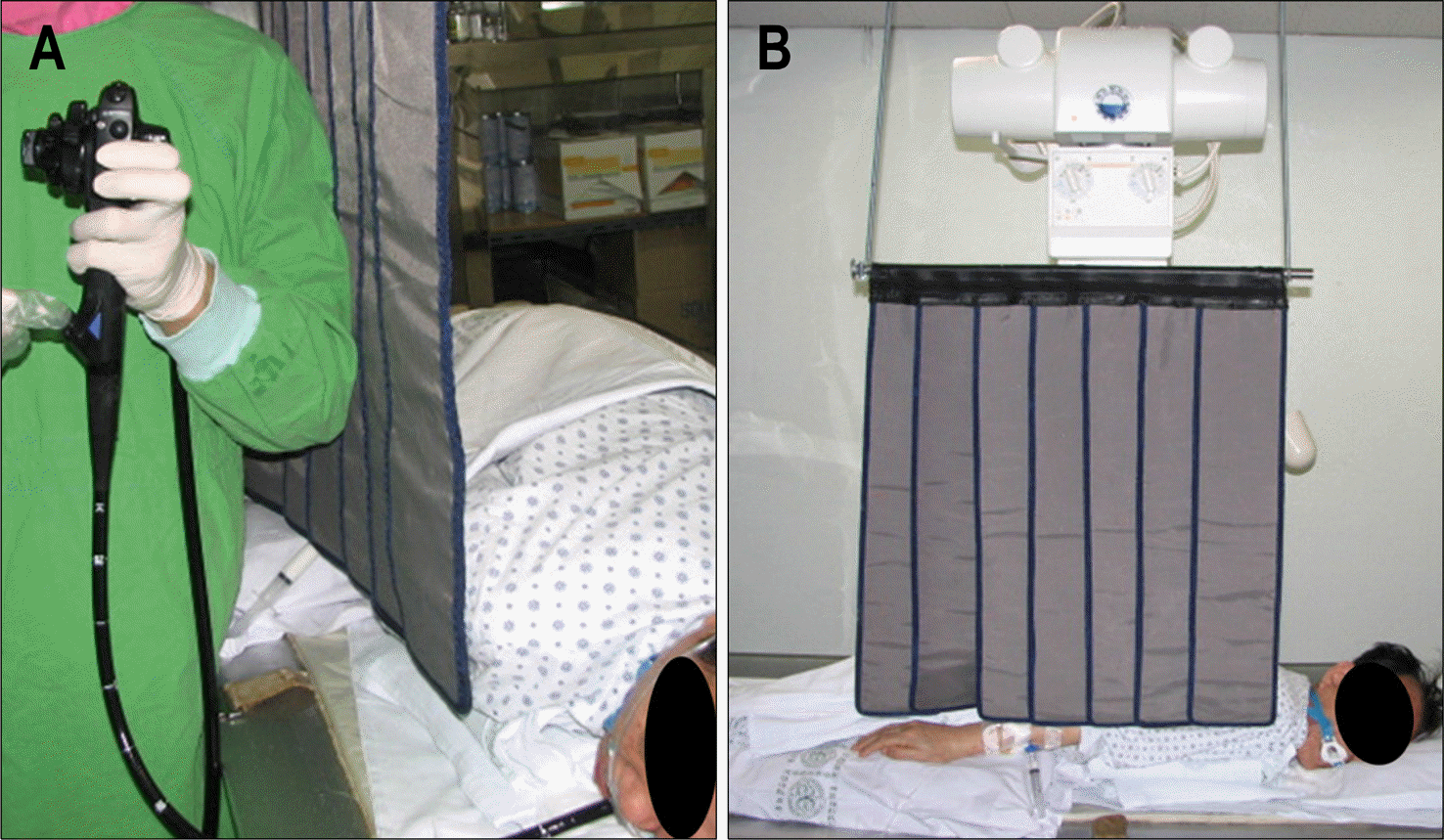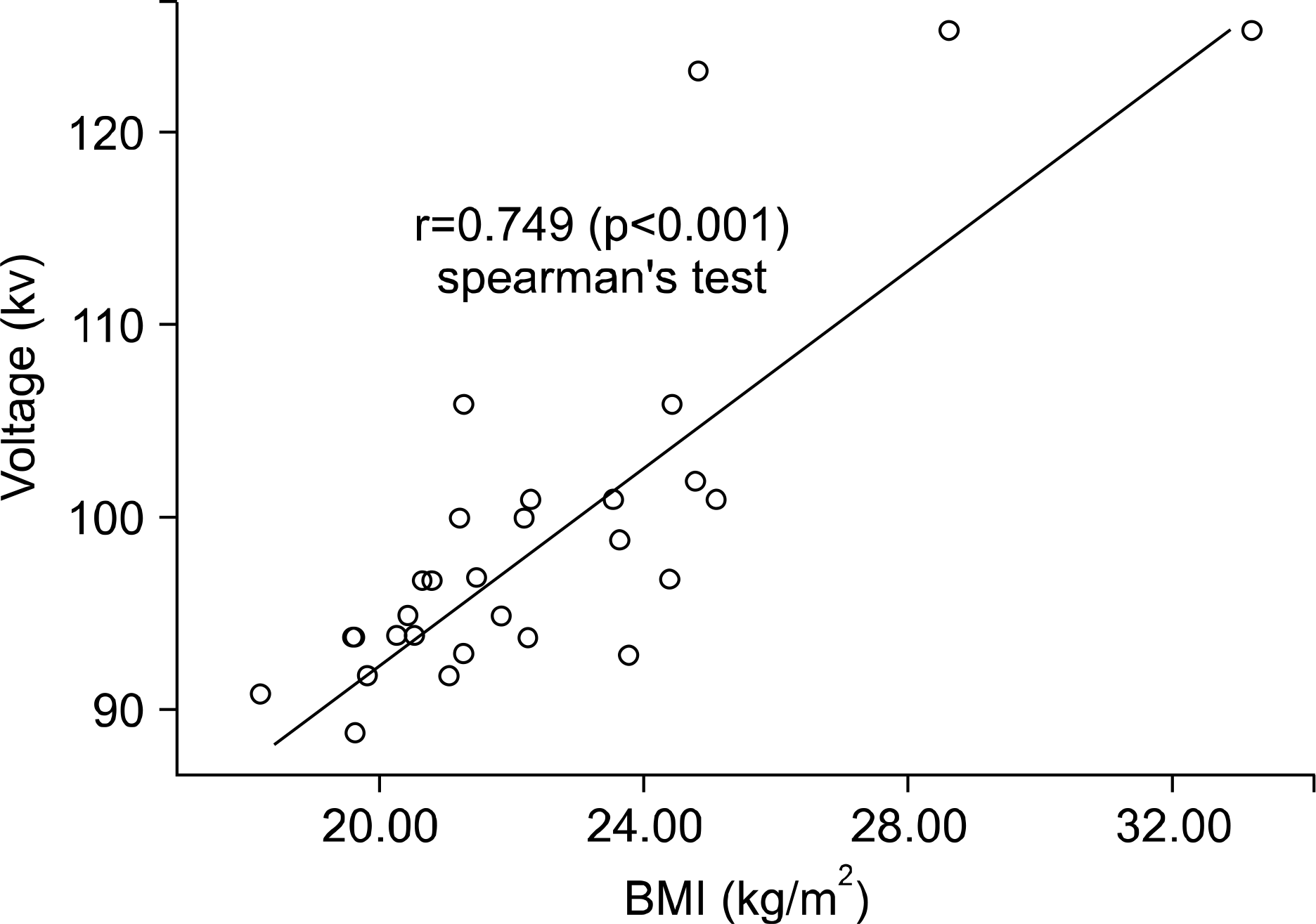Abstract
Background/Aims
The increasing use of diagnostic and therapeutic endoscopic retrograde cholangiopancreatography (ERCP) calls for greater consideration of radiation exposure risk to endoscopists and assistants, and emphasizes the proper system of radiation protection. This study was designed to assess the effect of a newly developed, self-designed, protective lead shield.
Methods
A curtain-shaped protective shield composed of seven movable lead plates was developed, each with the following dimensions: depth, 0.1 cm; width, 15 cm; length, 70 cm. The curtain-shaped protective shield was designed to be located between the patient and the endoscopist. Twenty-nine patients (11 men and 18 women) undergoing ERCP between January 2010 and March 2010 were selected for this study. The dose of radiation exposure was recorded with or without the protective lead shield at the level of the head, chest, and pelvis. The measurement was made at 50 cm and 150 cm from the radiation source.
Results
The mean patient age was 64 years. The mean patient height and weight was 161.7±6.9 cm and 58.9±9.9 kg, respectively. The mean body mass index (BMI) was 22.5±3.0 kg/m2. Endoscopists received 1522.2±537.0 mR/hr without the protective lead shield. At the same distance, radiation exposure was significantly reduced to 68.8±88.0 mR/hr with the protective lead shield (p-value<0.0001). The radiation exposure to endoscopists and assistants was significantly reduced by the use of a protective lead shield (p value <0.0001). The amount of radiation exposure during ERCP was related to the patient's BMI (r=0.749, p=0.001).
References
1. Selmaier M, Stillkrieg W, Müller RG, Hahn EG, Ell C. Radiation burden in diagnostic and therapeutic endoscopic retrograde cholangiopancreatography (ERCP). Z Gastroenterol. 1994; 32:671–674.
2. Peters PE, Katz G, Safrany L, Weitemeyer R. Radiation exposure in patients undergoing endoscopic retrograde cholangiopancreatography and endoscopic papillotomy. Gastrointest Radiol. 1978; 3:353–355.

3. Wagner RH, Boles MA, Henkin RE. Treatment of radiation exposure and contamination. Radiographics. 1994; 14:387–396.

4. Cohen RV, Aldred MA, Paes WS, et al. How safe is ERCP to the endoscopiest? Surg Endosc. 1997; 11:615–617.
5. Strzelczyk JJ, Damilakis J, Marx MV, Macura KJ. Facts and controversies about radiation exposure, part 1: controlling unnecessary radiation exposures. J Am Coll Radiol. 2006; 3:924–931.

6. Campbell N, Sparrow K, Fortier M, Ponich T. Practical radiation safety and protection for the endoscopist during ERCP. Gastrointest Endosc. 2002; 55:552–557.

7. International Commission on Radiological Protection. 1990 recommendations of the International Commission on Radiological Protection: adopted by the Commission in November 1990. 1st ed.Oxford: Pergamon;1991.
8. Larkin CJ, Workman A, Wright RE, Tham TC. Radiation doses to patients during ERCP. Gastrointest Endosc. 2001; 53:161–164.

9. Kimmey MB, AI-Kawas FH, Burnett DA, Carr-Locke DL, Gannan RM, Saeed ZA. Radiation safety during endoscopy. Gastrointest Endosc. 1994; 40:801–804.
10. Johlin FC, Pelsang RE, Greenleaf M. Phantom study to determine radiation exposure to medical personnel involved in ERCP fluoroscopy and its reduction through equipment and behavior modifications. Am J Gastroenterol. 2002; 97:893–897.

11. Heyd RL, Kopecky KK, Sherman S, Lehman GA, Stockberger SM. Radiation exposure to patients and personnel during interventional ERCP at a teaching institution. Gastrointest Endosc. 1996; 44:287–292.

Fig. 1.
Self-designed, protective lead shield. (A) Self-designed, protective lead shield consists of vertically-flexible, disposable, radiation-protective drapes placed directly on the patient in the sterile field. (B) The lead shield does not interfere with the performance of endoscopic procedures, or with fluoroscopic or video endoscopic visualization.

Fig. 2.
Relation graph between BMI and radiation exposure. The amount of radiation exposure during ERCP was strongly related to the patient's BMI. BMI, body mass index; ERCP, endoscopic retrograde cholangio pancreatography.

Table 1.
Clinical Characteristics of Patients and the Procedure
Table 2.
BMI and Amounts of Voltage during ERCP in 29 Patients
Table 3.
The Comparision of Radiation Exposure in Endoscopist and Assistant Staff during ERCP with or without the Protectiv Lead Shield




 PDF
PDF ePub
ePub Citation
Citation Print
Print


 XML Download
XML Download